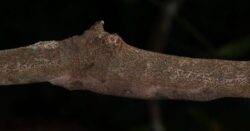Somewhere on this branch lies a gecko (picture rotated 90 degrees) (Picture: Dr Mark D Scherz/Natural History Museum of Denmark)
A new species of gecko has wowed scientists with its powers of disguise, using camouflage and special skin flaps to melt into its surroundings.
The leaf-tailed gecko species, Uroplatus garamaso, was discovered by a team of scientists in Madagascar, an island famed for its vast array of stunning – and often weird – wildlife.
Camouflage, also known as cryptic colouration, enables organisms to mimic their surroundings and blend into the background, helping them both avoid predators and surprise prey.
In the case of the garamaso gecko, its incredible camouflage skills enable it to remain hidden during the day, before prowling the forest at night for insects to dine on.
Alongside perfectly matching the colour of its hiding place, skin flaps around the lizard’s head, body and limbs, combined with a flattened tail, mean it doesn’t create a shadow while hiding in plain sight under the Madagascar Sun.
The lizard, which measures about 20cm from nose to tail, has also been lying under the noses of scientists, who first spotted it in 2000. However, it has taken until now to determine garamaso is a distinct species from another flat-tailed gecko, Uroplatus henkeli.
There she is (Picture: Dr Mark D Scherz/Natural History Museum of Denmark)
It took several expeditions to the island to gather enough data to make a definitive case, but one thing that tipped the balance was the lizard’s tongue. The new species, garamaso, has a black tip of the tongue, compared to the pink of its close relative. It is also slightly smaller.
‘This is quite common for reptiles from Madagascar’ said Dr Jörn Köhler, of the Hessisches Landesmuseum Darmstadt, a museum in Germany. ‘There are a lot of these so-called “cryptic species” which are waiting for taxonomic treatment.’
It took some time to confirm the gecko was an entirely new species (Picture: Dr Mark D Scherz/Natural History Museum of Denmark)
Dr Mark Scherz, curator of herpetology at the Natural History Museum of Denmark, added: ‘We are close to completing the taxonomic inventory of the genus, but this is just the start of our understanding of their evolution and ecology.
‘The mouth colour, which has been so useful to identify different species, has a totally unknown function. There is a lot we still do not know about these geckos, from their broader evolutionary relationships to their behaviour.’
The study is published in the German Journal of Herpetology.
MORE : New animal species found in Turkey could have been hiding there for millions of years
MORE : Scientists discover new ancient species with ‘cartoon grin’
Somewhere in this picture is a gecko.




